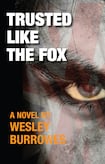
Bill Burgess, like his creator Wesley Burrowes, is a Northern Ireland man living and working in Dublin as a television editor and scriptwriter. The year is 1972. An explosion has occurred at a pub in a town in the North, and Burgess, catching sight of the place on the television news, has decided to pay it a visit.
The location of the atrocity is the town in which he spent a year of his childhood during the second World War, and to which he has not returned in 30 years. But here he is now, driving north on a whim, and about to fall foul of his erstwhile schoolmates and allies. The affable but stubborn narrator’s journey back to childhood territory will not prove rewarding .
Burrowes, who died in 2015, is best known for RTÉ drama series, including The Riordans, Bracken, and Glenroe.
Trusted Like the Fox is his only novel, and its theme is sectarian hatred and its ruinous effects. At the same time, it is pleasantly wry in tone, occasionally exuberant and witty, and shows a good grasp of Ulster idioms and catchphrases. "Standin' there runnin' about … I declare to God they'd put years on you."
The narrative moves between the wartime past and the murderous present. Burgess, blithely driving a car with a southern registration, has seriously underestimated the atmosphere of threat and tension pervading his old stamping ground, with its gospel halls, its Brethren of the Elect of God, its Rev Hugh Hanna Memorial Band, and the rest of it.
(Burrowes calls the place Duncairn, but it is clearly identifiable as Antrim town, even without the naming of actual localities nearby: Dunadry, Muckamore, the Lough Shore, Randalstown.)
‘What are you after?’
A loyalist pub has been blown up, causing a death and injuries; in retaliation, a local Catholic has been shot in his bed. (“Every member of the Catholic community … is a legitimate target.”)
The town is awash in Protestant paramilitaries, some of them old companions, and none of them happy to renew the acquaintance. “What are you doin’ here, Billy? What are you after?”
As a Protestant himself, and current “Free State” resident, he should have known better. “I was a long time gone,” he reflects. “I had forgotten.” What he has forgotten is the depth of bitterness and strength of purpose animating the loyalist community, with its immemorial opposition to what it calls the “Enemies of Faith and Freedom”.
And Duncairn in particular is so caught up in Orange militarism that the town’s more expedient Catholics have seen no option but to “turn”. Switches of allegiance are a fact of life. The thought has even crossed the mind of the young Burgess that his ghastly Orange grandmother is herself a turncoat, with her vituperative attitude towards Papists suggesting she once was one.
Sectarian edge
There is a sectarian edge to Burgess’s boyhood antics as part of a ragamuffin gang, but it’s kept, more or less, at a level of cockiness and high spirits. The grown-up version is deadlier and more implacable. There’s a reason why the adult Burgess is unwelcome in the town but he doesn’t see it. As a character, Burgess is infuriatingly foolhardy, like one of those Victorian heroines who keep putting themselves in harm’s way to further the plot. He is constantly deciding to leave and then not leaving, despite the threats and the violence to which he is subjected. A young woman has a part in his reluctance to drive away while he can, even though he knows she, like others, is acting on instructions.
Trusted Like the Fox gives an indication of what an uninvolved person is up against when tribal intransigence comes to the fore, and the worst gain paramilitary authority. The novel makes compelling reading – part thriller, part Ulster horror story – so you can forgive the odd unimportant error. For example: in June 1941 there is some dispute among the 10-year-olds of Duncairn over who should buy the latest issue of the Magnet, when this comic had ceased publication in March 1940. And – more seriously – Burgess, driving through Belfast on June 30th, 1972, on his way to north, could hardly have spotted the "remains" of bonfires on patches of waste ground, since the largest possible bonfires would still have been under construction in the run-up to the Twelfth.
Patricia Craig’s most recent book is Bookworm: a Memoir of Childhood Reading











